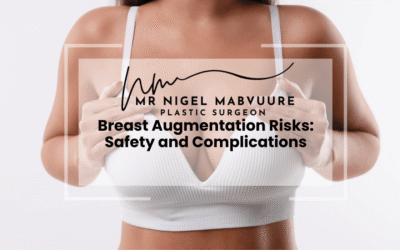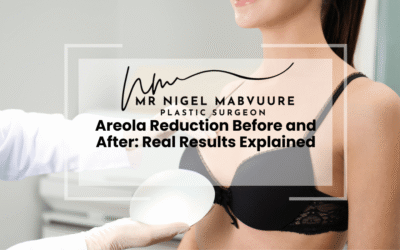Key Takeaways: Breast Surgery in Cheshire
- Breast surgery options in Cheshire include augmentation, reduction, lift, and reconstruction procedures, each tailored to individual needs and goals.
- When performed by qualified specialists in accredited facilities, breast surgery maintains an excellent safety profile with high patient satisfaction rates.
- The complete breast surgery journey involves thorough consultation, pre-operative assessment, the procedure itself, and structured follow-up appointments.
- Breast augmentation typically costs £4,500-£7,000 in Cheshire, with reductions starting from £5,500 and lifts ranging from £4,800-£6,500.
- Proper preparation 4-6 weeks before surgery includes lifestyle adjustments, medication management, and practical arrangements for recovery.
- Recovery progresses from initial discomfort (first 48 hours) to significant improvement (2-4 weeks) to final results (3-6 months).
- Choosing the right surgeon requires verifying credentials, reviewing experience, examining before-and-after portfolios, and trusting your consultation experience.
Table of Contents
- Understanding Breast Surgery: Types and Procedures in Cheshire
- Is Breast Surgery Safe? Understanding Risks and Benefits
- The Breast Surgery Journey: Consultation to Recovery
- How Much Does Breast Surgery Cost in Cheshire?
- Preparing for Your Breast Augmentation: Essential Steps
- Recovery Timeline: What to Expect After Breast Surgery
- Choosing the Right Breast Surgeon in Cheshire
Understanding Breast Surgery: Types and Procedures in Cheshire
Breast surgery encompasses a range of procedures designed to enhance, reduce, or reconstruct the breasts. In Cheshire, patients have access to world-class surgical expertise for various breast procedures. The most common types include breast augmentation (enlargement using implants), breast reduction (removing excess tissue to reduce size), breast lift (mastopexy to raise and reshape sagging breasts), and breast reconstruction (rebuilding the breast following mastectomy).
Breast augmentation remains the most sought-after procedure in Cheshire, with silicone and saline implants being the primary options. Silicone implants offer a more natural feel and appearance, while saline implants can be inserted through smaller incisions. For those seeking enhancement without implants, fat transfer breast augmentation utilises the patient’s own fat cells harvested from other body areas.
Breast reduction surgery addresses physical discomfort caused by overly large breasts, including back pain, shoulder grooves, and skin irritation. The procedure removes excess breast tissue, fat, and skin to achieve a more proportionate size. Meanwhile, breast lift procedures target sagging by removing excess skin and tightening surrounding tissue to reshape and support the new breast contour.
Each procedure is tailored to the individual’s anatomy, aesthetic goals, and lifestyle considerations. Cheshire clinics offer personalised consultations to determine the most appropriate surgical approach for each patient’s unique circumstances.
Is Breast Surgery Safe? Understanding Risks and Benefits
Breast surgery, when performed by qualified specialists in accredited facilities, maintains an excellent safety profile. In Cheshire, breast procedures are conducted under strict medical protocols with comprehensive pre-operative assessments to minimise risks. However, as with any surgical intervention, it’s essential to understand both the benefits and potential complications.
The safety of breast surgery has improved significantly with advanced techniques and technology. Modern implants undergo rigorous testing for safety and durability, while surgical approaches have evolved to reduce recovery time and complications. Most patients experience successful outcomes with high satisfaction rates, particularly when they have realistic expectations and follow all pre and post-operative guidance.
Potential risks include infection, bleeding, changes in nipple sensation, asymmetry, scarring, and implant-related complications such as capsular contracture (hardening of scar tissue around implants). Specific to breast reduction, risks may include difficulties with breastfeeding and potential unevenness. The likelihood of serious complications remains low, especially with proper surgical planning and aftercare.
It’s worth noting that the UK’s regulatory framework for cosmetic surgery is among the most stringent globally. Cheshire clinics adhere to strict safety standards, with surgeons regularly updating their skills and knowledge. During your consultation, your surgeon should provide a detailed explanation of all potential risks specific to your chosen procedure and individual health profile.
For long-term safety monitoring, regular follow-up appointments are recommended, particularly for patients with breast implants. Before and after insights from breast enhancement procedures demonstrate the transformative yet safe results achieved for patients in the Northwest region.
The Breast Surgery Journey: Consultation to Recovery
The breast surgery journey begins with a comprehensive consultation at your chosen Cheshire clinic. During this initial appointment, you’ll discuss your goals, medical history, and concerns with your surgeon. This is the time to ask questions and gain a thorough understanding of what the procedure entails. Your surgeon will examine your breasts, take measurements, and may use imaging technology to visualise potential results.
Once you’ve decided to proceed, a pre-operative assessment follows, including blood tests and possibly a mammogram depending on your age and medical history. Your surgical team will provide detailed instructions on preparing for surgery, including guidance on medications, smoking cessation, and fasting requirements.
On the day of surgery, most breast procedures in Cheshire are performed under general anaesthesia and typically take between 1-3 hours, depending on complexity. Breast augmentation and lifts generally require 1-2 hours, while reductions may take 2-3 hours. Many procedures are conducted as day cases, though some patients may require an overnight stay.
Immediately after surgery, you’ll be monitored in a recovery area until the effects of anaesthesia subside. You’ll likely experience some discomfort, swelling, and bruising, which are managed with prescribed pain medication. Most patients wear a special surgical bra or compression garment to support the healing tissues and minimise swelling.
Follow-up appointments are scheduled at regular intervals to monitor your healing progress. Initial reviews typically occur within the first week, with subsequent check-ups at 6 weeks, 3 months, and 6 months post-surgery. These appointments ensure optimal healing and allow your surgeon to address any concerns promptly.
Throughout this journey, Cheshire clinics prioritise patient education and support, ensuring you feel informed and comfortable at each stage of the process.
How Much Does Breast Surgery Cost in Cheshire?
The cost of breast surgery in Cheshire varies depending on the specific procedure, surgeon expertise, facility fees, and the complexity of your case. Understanding these factors helps in budgeting appropriately for your transformation journey.
Breast augmentation typically ranges from £4,500 to £7,000 in Cheshire clinics. This price generally includes the surgeon’s fee, anaesthesia, implants, facility costs, and follow-up appointments. Premium implants or more complex techniques may increase the overall cost. Breast reduction procedures usually start from £5,500, reflecting the technical complexity and longer operating time required.
Breast lift (mastopexy) procedures range from £4,800 to £6,500, with combined lift and augmentation procedures costing between £6,500 and £9,000. Revision surgeries or corrective procedures may have higher price points due to their complexity and the additional skill required.
When comparing costs across Cheshire clinics, it’s essential to understand exactly what’s included in the quoted price. Some facilities offer all-inclusive packages covering consultations, surgery, aftercare, and any necessary revisions, while others may charge these components separately. Additionally, many Cheshire clinics offer financing options with monthly payment plans to make breast surgery more accessible.
While cost is an important consideration, it shouldn’t be the primary factor in your decision-making process. The surgeon’s qualifications, experience, and your comfort with their approach should take precedence. Investing in quality care from reputable Cheshire clinics helps ensure optimal results and reduces the likelihood of complications or revision surgeries, which could ultimately prove more costly.
Preparing for Your Breast Augmentation: Essential Steps
Proper preparation is crucial for a successful breast augmentation experience in Cheshire. The preparation phase typically begins 4-6 weeks before your scheduled surgery date. During this period, your surgeon will provide comprehensive guidelines tailored to your specific health profile and surgical plan.
Lifestyle adjustments play a significant role in preparation. Smokers must cease smoking at least 4 weeks before surgery, as nicotine impairs healing and increases complication risks. Alcohol consumption should be minimised or eliminated in the two weeks leading up to surgery. Maintaining a stable, healthy weight before your procedure helps ensure optimal, lasting results.
Medication management is equally important. You’ll need to avoid blood-thinning medications and supplements, including aspirin, ibuprofen, vitamin E, and certain herbal preparations like ginkgo biloba and St. John’s wort. Provide your surgeon with a complete list of all medications and supplements you take regularly to receive specific guidance.
Practical preparations for your recovery period are essential. Arrange for someone to drive you home after surgery and stay with you for at least the first 24 hours. Prepare your recovery space with pillows for elevation, easy-to-reach necessities, and loose, comfortable clothing that opens at the front. Stock your kitchen with healthy, easy-to-prepare meals and ensure all prescriptions are filled before your surgery date.
In the 24 hours before surgery, follow fasting instructions precisely—typically no food or drink after midnight. Shower with antibacterial soap as directed, and remove all jewellery, contact lenses, and nail polish before arriving at the clinic. Wear comfortable, loose-fitting clothes with front closures to accommodate post-surgical dressings and limited mobility.
Mental preparation is equally valuable. Set realistic expectations by reviewing before-and-after photos of similar cases and thoroughly discussing anticipated outcomes with your surgeon. Many Cheshire patients find it helpful to prepare a list of questions to address any lingering concerns at their final pre-operative appointment.
Recovery Timeline: What to Expect After Breast Surgery
Recovery from breast surgery follows a predictable timeline, though individual experiences may vary based on the specific procedure and personal healing factors. Understanding this timeline helps Cheshire patients plan appropriately and maintain realistic expectations throughout their healing journey.
The first 24-48 hours post-surgery are typically the most challenging. You’ll experience discomfort, swelling, and possibly nausea from anaesthesia. During this period, rest is essential, with movement limited to light walking to promote circulation. Pain management through prescribed medication is crucial, and you’ll need assistance with daily activities.
By the end of the first week, discomfort begins to subside significantly. Most patients can manage with over-the-counter pain relief by this stage. Initial dressings are usually removed or changed at your first follow-up appointment, though you’ll continue wearing a surgical support bra 24 hours a day. Limited arm movements are permitted, but reaching and lifting remain restricted.
The 2-4 week period marks substantial improvement in comfort and mobility. Most Cheshire patients return to desk-based work within 10-14 days, though physically demanding occupations require 3-4 weeks off. Bruising begins to fade, though swelling persists. You’ll transition to a sports bra, wearing it day and night for continued support. Light exercise like walking can resume, but strenuous activities, particularly those involving the chest and arms, remain off-limits.
At 6 weeks post-surgery, most patients reach a significant recovery milestone. The majority of swelling subsides, though residual swelling may persist for several months, particularly after breast reduction. Most physical restrictions are lifted, allowing a gradual return to normal exercise routines, though chest-specific exercises should be reintroduced cautiously.
Complete healing and final results become apparent between 3-6 months post-surgery. Scars continue to mature and fade over 12-18 months. Breast implants settle into their final position during this period, a process sometimes called “dropping and fluffing” as they soften and take on a more natural appearance. Regular follow-up appointments with your Cheshire surgeon ensure your recovery progresses as expected.
Choosing the Right Breast Surgeon in Cheshire
Selecting the right breast surgeon in Cheshire is perhaps the most crucial decision in your surgical journey. The surgeon’s expertise directly influences your safety, results, and overall experience. Begin your search by verifying credentials and specialisation. Look for surgeons registered with the General Medical Council (GMC) and members of professional bodies such as the British Association of Aesthetic Plastic Surgeons (BAAPS) or the British Association of Plastic, Reconstructive and Aesthetic Surgeons (BAPRAS).
Experience specifically in breast procedures is essential. Inquire about how many breast surgeries the surgeon performs annually and their experience with your particular procedure. A specialist who focuses primarily on breast surgery will likely have more refined techniques and better understanding of potential complications than a general plastic surgeon.
Review the surgeon’s portfolio of before-and-after photographs, particularly of patients with similar body types and concerns to yours. This provides insight into their aesthetic style and consistency of results. Many Cheshire clinics maintain extensive galleries of previous work, though remember these typically showcase their best outcomes.
The consultation experience offers valuable insights into the surgeon’s approach. A reputable breast surgeon should listen attentively to your goals, conduct a thorough examination, and provide realistic expectations about outcomes. They should explain all available options, including the benefits and limitations of each, without pressuring you toward a particular choice or upselling additional procedures.
Patient reviews and testimonials provide real-world perspectives on the surgical experience. Look beyond star ratings to understand specific aspects of care, such as communication quality, availability for follow-up questions, and how complications were handled. Consider seeking recommendations from your GP or from friends who have undergone similar procedures in Cheshire.
Finally, trust your instincts. The right surgeon should make you feel comfortable, respected, and confident in their abilities. If something feels amiss during your consultation or you feel rushed or pressured, consider seeking a second opinion. The patient-surgeon relationship is crucial to a positive breast surgery experience, and finding the right match in Cheshire is worth the investment of time and research.
Frequently Asked Questions
How long do breast implants last?
Modern breast implants don’t have a specific expiration date but typically last 10-20 years. Manufacturers often provide lifetime warranties for implant rupture and 10-year warranties for capsular contracture. Regular monitoring through annual check-ups is recommended, and MRI scans every 5-7 years can detect silent ruptures in silicone implants. Replacement may be necessary due to complications, aesthetic changes, or personal preference rather than a predetermined timeframe.
What is the difference between silicone and saline breast implants?
Silicone implants contain a cohesive gel that closely mimics natural breast tissue, offering a more natural look and feel. They require a slightly larger incision for placement. Saline implants contain sterile salt water, can be inserted through smaller incisions, and if ruptured, the saline is safely absorbed by the body. Silicone implants are more popular in Cheshire due to their natural results, while saline implants may be preferred for patients concerned about silent ruptures or those wanting smaller incisions.
Will I lose nipple sensation after breast surgery?
Changes in nipple sensation are possible after breast surgery, ranging from temporary numbness to increased sensitivity. Approximately 15-20% of patients experience some permanent alteration in sensation. The risk varies by procedure type, with breast reduction carrying higher risks than augmentation. Surgical techniques that preserve the nipple-areolar complex connection to nerve pathways reduce this risk. Most temporary changes resolve within 6-12 months as nerve regeneration occurs.
How painful is breast augmentation recovery?
Breast augmentation recovery involves moderate discomfort rather than severe pain. The first 3-5 days typically present the most discomfort, described as pressure or muscle soreness similar to an intense workout. Pain is managed with prescription medication initially, transitioning to over-the-counter options within a week. Submuscular implant placement generally causes more discomfort than subglandular placement. Most patients return to desk jobs within 7-10 days and resume normal activities by 6 weeks post-surgery.
Can I breastfeed after having breast surgery?
Breastfeeding remains possible for many women after breast surgery, though success rates vary by procedure. Breast augmentation with incisions away from the areola (such as inframammary fold incisions) preserves milk ducts and nerves essential for lactation, with approximately 80% of patients able to breastfeed successfully. Breast reduction and lift procedures carry higher risks of breastfeeding difficulties as they may involve removal of glandular tissue or nipple repositioning. Discussing future breastfeeding plans with your Cheshire surgeon allows for technique modifications to maximize breastfeeding potential.
What size breast implants should I choose?
The ideal breast implant size depends on your body proportions, chest width, tissue characteristics, and aesthetic goals rather than cup size alone. Most Cheshire surgeons recommend selecting implants that complement your frame while considering lifestyle factors like physical activity levels. During consultation, surgeons use sizers, 3D imaging, or the rice test (filling bags with measured rice to simulate different volumes) to visualize potential outcomes. The most natural results typically come from implants proportionate to your body, with most patients choosing between 250-400cc implants for moderate enhancement.
How visible will my breast surgery scars be?
Breast surgery scars vary by procedure but generally fade significantly over time. Augmentation scars range from 3-5cm and are strategically placed in natural creases (inframammary fold), around the areola, or in the armpit. Breast reduction and lift procedures require more extensive incisions, typically resulting in an anchor or lollipop pattern. Scars appear red and raised initially but flatten and fade to thin white lines within 12-18 months. Proper wound care, silicone sheets/gel, sun protection, and avoiding smoking significantly improve scar appearance. Most Cheshire patients find their scars become inconspicuous and well worth the aesthetic improvements achieved.




